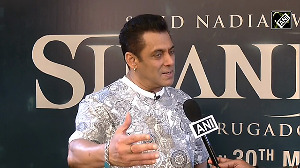'Obviously, there is always an argument that a weaker rupee could push up, to some, extent exports.'
'The fact that the rupee has appreciated against the Chinese currency is pushing a lot of Chinese imports into the Indian market.'

Illustration: Dominic Xavier/Rediff.com
"The rupee has appreciated against the dollar quite a bit in the last couple of months and a part of this could be because of the confidence in the Indian economy," Dr Soumya Kanti Ghosh, group chief economic advisor, State Bank of India, tells Rediff.com's Vaihayasi Pande Daniel in the concluding part of the interview.
- Part 1 of the Interview: 'Recovery could be a couple of quarters away'
- Part 2: 'You have to give very good credit to Modi'
- Part 3: 'Lot of positives happening in the economy now'
Will there still be a 3.2 per cent fiscal deficit target?
That I am not sure what kind of fiscal deficit because there is a lot of debate on that. At the end of the day I think (Finance Minister Arun) Jaitley has walked the path of fiscal prudence and I don't think he will easily abandon that in the last year or so.
What are some of the solutions that might work for some of the problems that do exist? Like jobs is a big problem.
Jobs are obviously an issue. The government needs to focus on certain sectors like the affordable housing sector, which has the maximum employment elasticity.
The other sectors (the government could focus on) should be the export-oriented ones, now that the global economy is moving up -- sectors like the textile sector, leather sector, the gems and jewellery.
These are some of the sectors which are export intensive and the government should try to see that these sectors can be promoted in a big manner.
The other thing the government must do: Women's participation in employment has been falling significantly over the last couple of years.
This is one area where the government needs to do a thorough check-up on how it can actually energise the women participation in the work force.
Women have always the dual role of maintaining their family and also doing their jobs.
One thing the government could do is to -- just saying this aloud -- the government should push more women into (working at) day care shelters (whose numbers are currently hugely lagging behind) in the urban areas.
The government can actually incentivise more women from rural areas to come in and sit at (man) these day-care centres, so women from the urban areas can use those day care centres.
That will kill two birds with one stone. It will push up women's participation in the employment grid and will also give more women employment at the lower end of the spectrum.
Also, the government needs to train people much (better). It could actually use the Mudra scheme (Pradhan Mantri Mudra Loan Yojana) and train people (by tying up) with private sector (to) train these entrepreneurs, who are getting loans from the government.
What are the one or two right things you see and what are one or two of the worrying things you see, as we stand here?
I would say most of the things are looking up quite well, in terms of the micro numbers, in terms of the financial stability, in terms of the macro numbers; so all of the numbers are looking good.
But two things which I would like to see settled -- maybe in the next one or two years and this is a very important -- one is the asset quality issues of the banks, which the government and the RBI is taking heed in terms of insolvency and bankruptcy.
That is one thing that government needs to solve and which will go on and recapitalise the banks.
I strongly believe if that is the one thing if done could solve 50 percent of your problems.
The other problem: The government needs to (look at) innovative ways to see how the employment growth could be given a strong feed.
There are a lot of positive things happening, but we need to, at least, address the issues of bank asset quality and employment generation head on. It will give a lot of (feed) to the market in terms of a positive booster sentiment.
So you would also say, for the people who doubt GST and demonetisation, that they should take hope in the fact that it gives a good message?
My only message is that never doubt the intentions with which these moves were done.
You can always say a lot of things. You can always debate on the implementation. But please don't doubt the intentions of these measures. I am sure the numbers should look up.
Some of the numbers might be a little bit difficult to comprehend, in terms of what will be the benefit, as I explained to you.
But over a point of time, I am sure, this will open up a lot of formalisation of the informal sector, that will broaden the GDP, give a boost to the growth rate and that will lead to higher tax collections.
As you know, if the tax collection (rates) go higher (those) benefits would come back to the direct tax payers, in terms of a lower personal income tax rate.
If that happens then obviously there will be a consumption boost to the economy, which could again drive GDP growth at a future date.
Everything has a cycle in it. More the formalisation of the economy through these moves, the more people will come into the tax net, so you should expect a lower personal tax rate or GST taxes in the near future and more purchasing power in the hands of the consumers.
More purchasing power will only add to the GDP at some point of time.
How is the rupee doing against the dollar? What does it look like?
See, the rupee has appreciated against the dollar quite a bit in the last couple of months and a part of this could be because of the confidence in the Indian economy.
A lot of (foreign) portfolio capital has been flowing into the country.
But some went out recently?
Some went out recently. But the rupee is still (strong).
If you ask me as an economist I would love to see a weak rupee, a little bit on the weaker side.
Why?
Obviously there is always an argument that a weaker rupee could push up, to some, extent exports.
The fact that the rupee has appreciated against the Chinese currency is pushing a lot of Chinese imports into the Indian market. That is one thing.
So I should like to see (the rupee) maybe a little bit weaker against the dollar.
Here again I want to work with a caveat. The Indian exports -- if you look into them -- are mostly income elastic rather than being price elastic.
Income elastic means that if the global economy grows, GDP grows, then Indian exports gain momentum.
And it is not always the case with price elasticity.
Of course, there are some exports that are price elastic like apparel for example. But these are mostly short term in nature.
I think export growth will pick up because of the global economy getting traction and we should try to remove some of the logistical issues which the exporters are facing like in terms of the GST rather than being too much concerned on the exchange rate.
As an economist, I would like to see the rupee a little weaker, but that doesn't mean exports will not grow if the rupee stayed at this level.
What do you feel about the government's plan to recapitalise public sector banks?
The proposed recapitalisation package has several features:
- Front-loaded capital injection.
- Liquidity neutral for the government except interest cost.
- Lendable resources to support credit growth and job creation.
Out of the Rs 2.11 lakh crores, the government would provide Rs 18,139 crores through budgetary provisions, Rs 1.35 lakh crores by recapitalisation bonds and the balance Rs 58,000 crores needs to be raised by banks from the market.
Recapitalisation of banks through recapitalisation bonds has precedence not only in India, but also in many other countries including Chile, the Philippines, Finland, Hungary, Argentina, Korea and Malaysia.
The obvious advantages of such bonds are that they do not alter the fiscal maths, as the government earns both dividends and market returns on bank shares.
The government need not raise immediate tax revenues and by borrowing directly from the banking system instead of the markets, the Centre can avoid crowding out private borrowings or distorting market yields.
Different countries have issued recapitalisation bonds to inject equity into the banking sector.
When its 'big four' State-owned banks were grappling with aggregate NPAs (non performing assets) of more than 30 per cent during the 1990s, the Chinese government had injected around $33 billion of capital financed by the sale of bonds to these banks to help improve their capital adequacy ratio.











 © 2025
© 2025